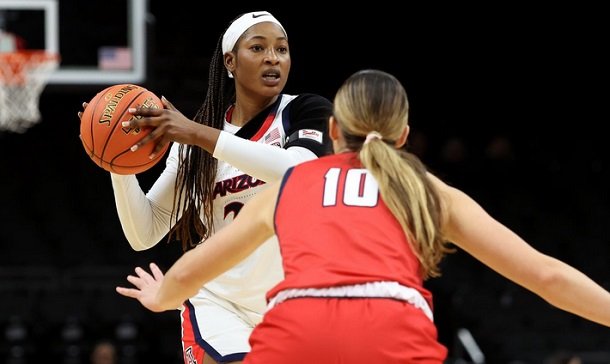Women’s college basketball quarters are each 10 minutes long. The game is divided into four quarters, with a 15-minute halftime break between the second and third quarters. If the game is tied at the end of regulation, overtime periods last 5 minutes each until a winner is determined.

How long are women’s College Basketball quarters?
The game is divided into four quarters, each lasting 10 minutes. Halftime There is a 15-minute halftime break between the second and third quarters. Overtime If the game is tied at the end of regulation, overtime periods are 5 minutes each and continue until a winner is determined. Breaks Short breaks occur between the first and second quarters and between the third and fourth quarters.
Game Structure: Women’s NCAA college basketball games are structured with four 10-minute quarters, a 15-minute halftime, and 5-minute overtime periods if needed.
Strategic Impact: The structure of four 10-minute quarters in women’s NCAA basketball allows for frequent strategy adjustments, better player rotation, and increased opportunities for rest and momentum shifts.
Understanding the Game: Understanding women’s NCAA basketball involves grasping its structure: four 10-minute quarters with strategic breaks, facilitating tactical adjustments and player management crucial for game momentum
Overtime Rules
In women’s NCAA basketball, overtime rules ensure a fair resolution to tied games:
- Overtime Periods: Each overtime period lasts 5 minutes.
- Continuation: Overtime periods continue until a winner is determined at the end of a complete period.
- Timeouts: Teams receive one additional timeout per overtime period.
- Fouls: Team fouls from regulation carry over into overtime, with players fouling out on their fifth personal foul.
- Possession: Possession is determined by alternating possessions, starting with a jump ball.
Comparison to Men’s College Basketball
Comparing women’s NCAA basketball overtime rules to men’s college basketball highlights some similarities and differences. Overtime Period Length Both men’s and women’s college basketball use 5-minute overtime periods. Timeouts Both allow one additional timeout per overtime period beyond those allocated in regulation. Fouls and Bonus Team fouls carry over from regulation in both, with players fouling out on their fifth personal foul in both men’s and women’s games. Possession Women’s basketball uses alternating possession to determine who gets the ball first in overtime, while men’s basketball typically uses a jump ball.
Game Play Flow
In women’s NCAA basketball, the game’s flow is structured around four 10-minute quarters, each punctuated by breaks and halftime, allowing for strategic adjustments and player management crucial to maintaining momentum and performance.
Summary of Key Timing Elements in Women’s College Basketball:
Key timing elements in women’s college basketball include:
Quarters: Four quarters, each lasting 10 minutes.
Halftime: A 15-minute break between the second and third quarters.
Overtime: 5-minute periods if the game is tied at the end of regulation.
Timeouts: Each team has four 75-second timeouts and one 30-second timeout per game.
These elements structure the game, allowing for strategic pauses, player rest, and momentum shifts crucial to the overall flow and outcome of matches.
Advanced Game Techniques
Advanced game techniques in women’s college basketball encompass a range of strategic and tactical approaches that elevate team performance:
Offensive Strategies:
- Pick-and-Roll: Utilizing screens to create mismatches and scoring opportunities.
- Motion Offense: Constant movement and passing to create open shots and confuse defenses.
- Fast Break: Quickly transitioning from defense to offense to capitalize on fast scoring chances.
- Spacing and Floor Balance: Ensuring players are properly positioned to stretch defenses and open up driving lanes.
Defensive Strategies:
- Man-to-Man Defense: Individual players guarding specific opponents to deny scoring opportunities.
- Zone Defense: Assigning players to cover specific areas of the court, forcing outside shots and limiting driving lanes.
- Press Defense: Applying full-court pressure to disrupt the opponent’s offense and create turnovers.
- Help Defense: Rotating and providing support to teammates to protect the basket and contest shots.
Situational Awareness:
- End-of-Game Scenarios: Managing the clock, fouls, and timeouts effectively to secure a win.
- Adjustments: Making quick adjustments in response to opponent strategies and game flow.
- Free Throw Management: Maximizing opportunities from the free-throw line and minimizing opponent chances.
These techniques require a deep understanding of game strategy, player capabilities, and opponent tendencies, highlighting the complexity and skill involved in women’s college basketball at the highest levels.
What is the duration of a quarter in NCAA women’s basketball?
In NCAA women’s basketball, each quarter lasts for 10 minutes.
How does the length of a women’s college basketball game differ from a men’s?
Women’s college basketball games are typically 40 minutes long, divided into four quarters of 10 minutes each. Men’s college basketball games are also 40 minutes long but are divided into two halves of 20 minutes each. Halftime Both men’s and women’s games have a halftime break, typically 15 minutes long. Overtime rules are generally the same for both, with additional 5-minute periods if the game is tied at the end of regulation.
How does the women’s college 3-point line distance compare to men’s?
NCAA basketball, including both men’s and women’s games, the distance of the 3-point line differs, Women’s College Basketball The 3-point line distance is currently set at 20 feet, 9 inches (6.32 meters) from the center of the basket. Men’s College Basketball The 3-point line distance is set at 22 feet, 1.75 inches (6.75 meters) from the center of the basket.
This difference in distance is intended to adjust for the physical and athletic differences between male and female players, influencing shooting strategies and game dynamics accordingly.





